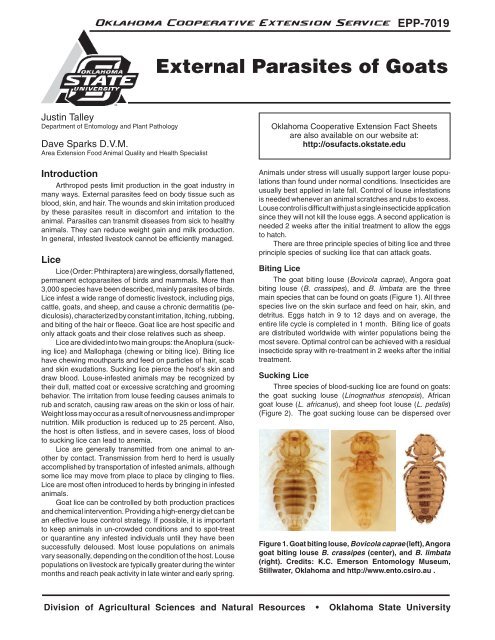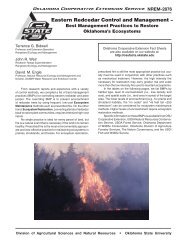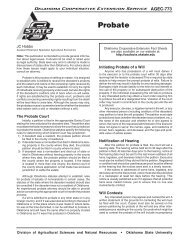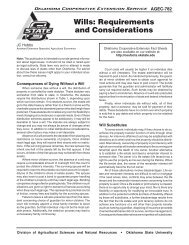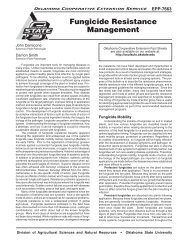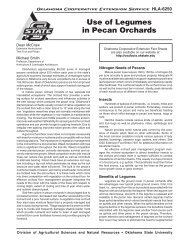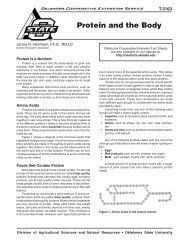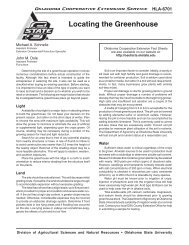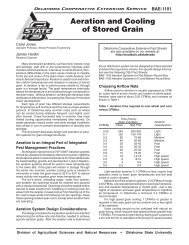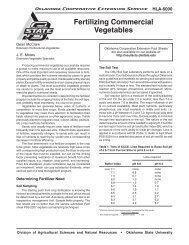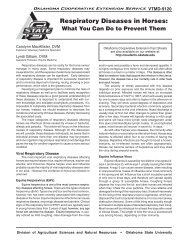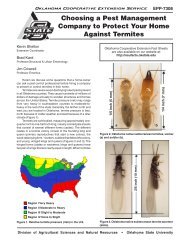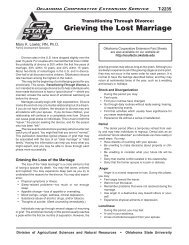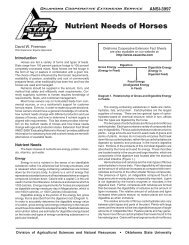External Parasites of Goats - OSU Fact Sheets - Oklahoma State ...
External Parasites of Goats - OSU Fact Sheets - Oklahoma State ...
External Parasites of Goats - OSU Fact Sheets - Oklahoma State ...
You also want an ePaper? Increase the reach of your titles
YUMPU automatically turns print PDFs into web optimized ePapers that Google loves.
<strong>Oklahoma</strong> Cooperative Extension Service<br />
Justin Talley<br />
Department <strong>of</strong> Entomology and Plant Pathology<br />
Dave Sparks D.V.M.<br />
Area Extension Food Animal Quality and Health Specialist<br />
Introduction<br />
Arthropod pests limit production in the goat industry in<br />
many ways. <strong>External</strong> parasites feed on body tissue such as<br />
blood, skin, and hair. The wounds and skin irritation produced<br />
by these parasites result in discomfort and irritation to the<br />
animal. <strong>Parasites</strong> can transmit diseases from sick to healthy<br />
animals. They can reduce weight gain and milk production.<br />
In general, infested livestock cannot be efficiently managed.<br />
Lice<br />
Lice (Order: Phthiraptera) are wingless, dorsally flattened,<br />
permanent ectoparasites <strong>of</strong> birds and mammals. More than<br />
3,000 species have been described, mainly parasites <strong>of</strong> birds.<br />
Lice infest a wide range <strong>of</strong> domestic livestock, including pigs,<br />
cattle, goats, and sheep, and cause a chronic dermatitis (pediculosis),<br />
characterized by constant irritation, itching, rubbing,<br />
and biting <strong>of</strong> the hair or fleece. Goat lice are host specific and<br />
only attack goats and their close relatives such as sheep.<br />
Lice are divided into two main groups: the Anoplura (sucking<br />
lice) and Mallophaga (chewing or biting lice). Biting lice<br />
have chewing mouthparts and feed on particles <strong>of</strong> hair, scab<br />
and skin exudations. Sucking lice pierce the host’s skin and<br />
draw blood. Louse-infested animals may be recognized by<br />
their dull, matted coat or excessive scratching and grooming<br />
behavior. The irritation from louse feeding causes animals to<br />
rub and scratch, causing raw areas on the skin or loss <strong>of</strong> hair.<br />
Weight loss may occur as a result <strong>of</strong> nervousness and improper<br />
nutrition. Milk production is reduced up to 25 percent. Also,<br />
the host is <strong>of</strong>ten listless, and in severe cases, loss <strong>of</strong> blood<br />
to sucking lice can lead to anemia.<br />
Lice are generally transmitted from one animal to another<br />
by contact. Transmission from herd to herd is usually<br />
accomplished by transportation <strong>of</strong> infested animals, although<br />
some lice may move from place to place by clinging to flies.<br />
Lice are most <strong>of</strong>ten introduced to herds by bringing in infested<br />
animals.<br />
Goat lice can be controlled by both production practices<br />
and chemical intervention. Providing a high-energy diet can be<br />
an effective louse control strategy. If possible, it is important<br />
to keep animals in un-crowded conditions and to spot-treat<br />
or quarantine any infested individuals until they have been<br />
successfully deloused. Most louse populations on animals<br />
vary seasonally, depending on the condition <strong>of</strong> the host. Louse<br />
populations on livestock are typically greater during the winter<br />
months and reach peak activity in late winter and early spring.<br />
EPP-7019<br />
<strong>External</strong> <strong>Parasites</strong> <strong>of</strong> <strong>Goats</strong><br />
<strong>Oklahoma</strong> Cooperative Extension <strong>Fact</strong> <strong>Sheets</strong><br />
are also available on our website at:<br />
http://osufacts.okstate.edu<br />
Animals under stress will usually support larger louse populations<br />
than found under normal conditions. Insecticides are<br />
usually best applied in late fall. Control <strong>of</strong> louse infestations<br />
is needed whenever an animal scratches and rubs to excess.<br />
Louse control is difficult with just a single insecticide application<br />
since they will not kill the louse eggs. A second application is<br />
needed 2 weeks after the initial treatment to allow the eggs<br />
to hatch.<br />
There are three principle species <strong>of</strong> biting lice and three<br />
principle species <strong>of</strong> sucking lice that can attack goats.<br />
Biting Lice<br />
The goat biting louse (Bovicola caprae), Angora goat<br />
biting louse (B. crassipes), and B. limbata are the three<br />
main species that can be found on goats (Figure 1). All three<br />
species live on the skin surface and feed on hair, skin, and<br />
detritus. Eggs hatch in 9 to 12 days and on average, the<br />
entire life cycle is completed in 1 month. Biting lice <strong>of</strong> goats<br />
are distributed worldwide with winter populations being the<br />
most severe. Optimal control can be achieved with a residual<br />
insecticide spray with re-treatment in 2 weeks after the initial<br />
treatment.<br />
Sucking Lice<br />
Three species <strong>of</strong> blood-sucking lice are found on goats:<br />
the goat sucking louse (Linognathus stenopsis), African<br />
goat louse (L. africanus), and sheep foot louse (L. pedalis)<br />
(Figure 2). The goat sucking louse can be dispersed over<br />
Figure 1. Goat biting louse, Bovicola caprae (left), Angora<br />
goat biting louse B. crassipes (center), and B. limbata<br />
(right). Credits: K.C. Emerson Entomology Museum,<br />
Stillwater, <strong>Oklahoma</strong> and http://www.ento.csiro.au .<br />
Division <strong>of</strong> Agricultural Sciences and Natural Resources • <strong>Oklahoma</strong> <strong>State</strong> University
Figure 2. Goat sucking louse, Linognathus stenopsis<br />
(left), African goat louse, L. africanus (center), and sheep<br />
foot louse, L. pedalis (right). Credits: K.C. Emerson Entomology<br />
Museum, Stillwater, <strong>Oklahoma</strong> and http://www.<br />
ento.csiro.au .<br />
the entire body <strong>of</strong> goats and the African goat louse is usually<br />
dispersed around the head, body, and neck regions. Both the<br />
goat sucking louse and the African goat louse are bluish-gray<br />
in appearance. The sheep foot louse is an occasional pest<br />
<strong>of</strong> goats and can be found on the feet or legs <strong>of</strong> the animal.<br />
These blood-feeding lice species cause the most severe damage.<br />
Excessive feeding causes scabby, bleeding areas that<br />
may lead to bacterial infection. Mohair on Angora goats may<br />
be damaged to the extent <strong>of</strong> reduction in value <strong>of</strong> 10 to 25<br />
percent. Control can be obtained utilizing the same methods<br />
described for biting lice.<br />
Nose Bot Fly<br />
The nose bot fly exhibits a unique quality by depositing<br />
live larvae (maggots) (Figure 3), not eggs as in the case <strong>of</strong><br />
other fly species, in the nostrils <strong>of</strong> goats. Larvae migrate to the<br />
head sinuses and, after development, migrate back down the<br />
nasal passages, dropping to the ground where they complete<br />
development. Migration <strong>of</strong> the bot larvae to and from the head<br />
sinuses causes nasal membranes to become irritated and<br />
secondary infections can occur at the irritation sites.<br />
Infested animals exhibit symptoms such as discharge from<br />
nostrils, extensive shaking <strong>of</strong> the head, loss <strong>of</strong> appetite and<br />
grating <strong>of</strong> teeth. Another sign <strong>of</strong> a nose bot infestation is the<br />
Figure 3. These are the larval instars <strong>of</strong> the nose bot fly.<br />
The third instar is at the top <strong>of</strong> the photograph, followed<br />
clockwise by the first and second instars. Credits: J.E.<br />
Lloyd, University <strong>of</strong> Wyoming.<br />
EPP-7019-2<br />
presence <strong>of</strong> blood flecks in the nasal discharge. The behavior<br />
<strong>of</strong> goats in the presence <strong>of</strong> adult bot flies is very excitatory<br />
and usually animals will snort with their noses towards the<br />
ground.<br />
At this time there is only one effective product available for<br />
the treatment <strong>of</strong> nose bots in goats. Ivomec® (ivermectin) is<br />
registered as a 0.08 percent AI oral drench. Since it is labeled<br />
for sheep only, you should contact your local veterinarian<br />
for <strong>of</strong>f-label prescribed usage and the correct dosage and<br />
withdrawal instructions for goats. Nose bots are usually<br />
a winter problem so treatment should be administered after<br />
the first hard frost, which kills the adult bot flies and assures<br />
no re-infestations.<br />
Keds<br />
Keds, more <strong>of</strong>ten called sheep ticks, are actually a wingless<br />
fly (Figure 4). They spend their entire life cycle on sheep<br />
or goats, transferring between animals by contact. Sheep<br />
keds, Melophagus ovinus, are primarily a pest <strong>of</strong> sheep, but<br />
occasionally are found on goats. Adults are grayish-brown,<br />
six-legged, and 1/4 inch long with a broad, leathery, somewhat<br />
flattened, unsegmented, saclike abdomen covered with short<br />
spiny hairs. Sheep keds can live up to 6 months, during which<br />
time the female produces around 10 to 15 young at the rate<br />
<strong>of</strong> one every 8 days. Reproduction is continuous, though slow<br />
during the winter, producing several generations per year.<br />
Unlike most insects, the female sheep ked gives birth to<br />
living maggots, which are nourished within her body until they<br />
are fully grown. The maggots are 1/4 inch long, whitish, oval,<br />
and without legs. The skin turns brown within a few hours<br />
after birth and forms a hard puparium (case) around the larva.<br />
These cases are <strong>of</strong>ten called eggs, nits, or keds. Adult keds<br />
emerge from the pupal cases in 2 to 5 weeks, depending on<br />
temperature. They crawl over the skin and feed by inserting<br />
their sharp mouthparts into capillaries and sucking blood,<br />
much like a mosquito. This results in considerable irritation,<br />
which causes the animal to rub, bite, and scratch. Another<br />
effect observed from animals infested with keds is the condition<br />
known as “cockle.” Hide buyers downgrade skins with<br />
“cockle” because it weakens the hide and discolors them.<br />
Keds usually do not cause great damage if the animal is<br />
fed on a highly nutritious diet, but goats grazed throughout<br />
the year on pasture or range may acquire heavy burdens <strong>of</strong><br />
Figure 4. Illustration <strong>of</strong> an adult sheep ked. Credits: D.<br />
Rutz Cornell University.
keds during winter months and early spring. In addition, keds<br />
in large numbers can cause anemia, which can weaken the<br />
animal and make it more susceptible to other diseases.<br />
Sprays, dips, and hand-dusting with insecticides are all<br />
effective methods for controlling sheep ked.<br />
Mites<br />
<strong>Goats</strong> can be infested by several species <strong>of</strong> mites, but<br />
the species more commonly found on goats are goat follicle<br />
mite (Demodex caprae), scabies mite (Sarcoptes scabiei),<br />
psoroptic ear mite (Psoroptes cuniculi), and chorioptic scab<br />
mite (Chorioptes bovis) (Figure 5).<br />
The goat follicle mite causes dermal papules and nodules<br />
and this resulting condition is known as demodectic mange in<br />
goats. These papules or nodules are caused by hair follicles or<br />
gland ducts becoming obstructed and producing these swellings,<br />
trapping the mites within these lesions. These continue<br />
to enlarge as the mites multiply, sometimes reaching several<br />
thousand mites per lesion. Cases <strong>of</strong> demodectic mange occur<br />
most commonly in young animals, pregnant does, and dairy<br />
goats. Papules usually appear on the face, neck, axillary<br />
region, or udder and these papules can enlarge to 4 cm in<br />
diameter as mites multiply. Nodules can rupture and exude the<br />
mites, resulting in transmission <strong>of</strong> the mite to other animals.<br />
Transmission <strong>of</strong> the goat follicle mite to newborn goats typically<br />
occurs within the first day following birth. Other possible<br />
means <strong>of</strong> transfer are licking and close contact during mingling<br />
or mating. Certain breeds <strong>of</strong> goat (e.g., Saanen) tend to be<br />
much more sensitive to demodectic mange than others.<br />
The scabies mite burrows into the skin <strong>of</strong> its host, causing<br />
varying degrees <strong>of</strong> dermatitis, a condition known as sarcoptic<br />
mange. Although cases <strong>of</strong> sarcoptic mange in goats <strong>of</strong>ten<br />
resolve themselves without developing severe signs, heavily<br />
infested goats may exhibit crusty lesions and extensive hair<br />
loss around the muzzle, eyes, and ears; lesions on the inner<br />
thighs extending to the hocks, brisket, underside, and axillary<br />
region; dermal thickening and wrinkling on the scrotum and<br />
ears; and dry, scaly skin on all parts <strong>of</strong> the body, especially<br />
in areas <strong>of</strong> hair loss.<br />
The psoroptic ear mite or ear mange mite causes lesions<br />
on or in the ear <strong>of</strong> the host animal. These lesions cause crust<br />
formation, foul odor discharges in the external ear canal,<br />
and behavioral responses such as scratching the ears, head<br />
shaking, loss <strong>of</strong> equilibrium, and spasmodic contractions <strong>of</strong><br />
neck muscles. Psoroptic ear mite lives its entire life under the<br />
margins <strong>of</strong> scabs formed at infested sites. There the eggs<br />
EPP-7019-3<br />
are deposited and hatch in 4 days. The complete life cycle<br />
takes about 3 weeks. All stages <strong>of</strong> this nonburrowing mite<br />
pierce the outer skin layer. Transmission <strong>of</strong> this mite occurs<br />
between animals by direct contact. Prevalence rates as high<br />
as 90 percent have been reported in dairy goats, including both<br />
kids and adults, in the United <strong>State</strong>s. <strong>Goats</strong> usually less than<br />
1 year old generally exhibit higher infestation rates than do<br />
older animals. Signs <strong>of</strong> the psoroptic ear mite in kids are <strong>of</strong>ten<br />
observed as early as 3 weeks after birth, reflecting transfer <strong>of</strong><br />
mites from mother to young. By 6 weeks <strong>of</strong> age, most kids in<br />
infested goat herds are likely to harbor these mites. Chronic<br />
infestations have lead to anemia and weight loss in goats.<br />
The chorioptic scab mite causes chorioptic mange in domestic<br />
animals, especially in cattle, sheep, goats, and horses.<br />
This mite occurs primarily on the legs and feet <strong>of</strong> its hosts,<br />
where all <strong>of</strong> the developmental stages are likely to be found.<br />
Eggs are deposited singly at the rate <strong>of</strong> one egg per day and<br />
are attached with a sticky substance to the host skin. Adult<br />
females usually live for 2 weeks or more, producing about<br />
14-20 eggs during this time. Eggs hatch in 4 days and are <strong>of</strong>ten<br />
clustered as multiple females lay their eggs in common sites.<br />
The immature stages last anywhere from 11 to 14 days and<br />
the entire life cycle is completed in 3 weeks. Infestations <strong>of</strong><br />
chorioptic scab mite tend to be higher in goats than in sheep,<br />
with up to 80 to 90 percent <strong>of</strong> goats in individual herds being<br />
parasitized. The mites occur most commonly on the forefeet<br />
<strong>of</strong> goats, where the largest numbers <strong>of</strong> mites and lesions are<br />
usually associated with the accessory claws. However, they<br />
also can occur higher on the foot. Lesions are generally mild<br />
and seldom draw attention.<br />
Treatment and control <strong>of</strong> mites should focus on all animals<br />
in a herd to achieve control. Delayed egg hatch requires retreatment<br />
at 10 to 12 days. To reduce the risk <strong>of</strong> introducing mites<br />
into herds, isolation <strong>of</strong> new animals should be practiced with<br />
at least a week to observe the animal for signs <strong>of</strong> mange.<br />
Fleas<br />
Adult fleas are small (1 to 8 mm), wingless insects that<br />
are narrow and are compressed on the sides with spines<br />
(combs) directed backwards. Most species move a great deal<br />
and remain on the host only part <strong>of</strong> the time to obtain a blood<br />
meal. The legs are well developed and are utilized to jump<br />
great distances (7 to 8 in.).<br />
Fleas develop through a complete life cycle with four<br />
stages: egg, larva, pupa, and adult. Under ideal conditions,<br />
a generation can be completed in as little as 2 weeks. Mating<br />
Figure 5. (left to right) Goat follicle mite, (Demodex caprae), scabies mite (Sarcoptes scabiei), psoroptic ear mite (Psoroptes<br />
cuniculi), and chorioptic scab mite (Chorioptes bovis). Credits: S.J. Upton, Kansas <strong>State</strong> University and Thomas<br />
Nolan, University <strong>of</strong> Pennsylvania.
takes place and eggs are laid on the host. Eggs then drop<br />
<strong>of</strong>f the host to the ground or bedding material and hatch in 2<br />
days but can delay hatching up to several weeks. Development<br />
<strong>of</strong> the larval and pupal stages occurs in the host’s bedding<br />
material. Larvae are very small, worm-like, legless insects<br />
with chewing mouthparts. In several weeks they go through<br />
3 larval stages, feeding on organic material. The pupal stage<br />
lasts approximately one week and then the newly emerged<br />
adult flea is ready to feed on blood within 24 hrs.<br />
There are two species that commonly infest goats: the cat<br />
flea (Ctenocephalides felis) and sticktight flea (Echidnophaga<br />
gallinacea) (Figure 6). Female cat fleas can lay up to 25 eggs<br />
per day for a month, contributing to very high densities <strong>of</strong> fleas<br />
in a relatively short time. Cases <strong>of</strong> severe anemia associated<br />
with high numbers <strong>of</strong> cat flea bites have been reported<br />
in domestic animals. The sticktight flea attaches firmly to its<br />
host usually around the face and ears. This species remains<br />
attached to its host for as long as 2 to 3 weeks. Large populations<br />
<strong>of</strong> this flea may cause ulcers on the head and ears.<br />
Both <strong>of</strong> these flea species can easily spread to other animals<br />
so special considerations <strong>of</strong> monitoring herd dogs should be<br />
implemented if fleas become a problem in a goat herd.<br />
Figure 6. Cat flea, Ctenocephalides felis, (left) and sticktight<br />
flea, Echidnophaga gallinacea, (right). Credits: S.J.<br />
Upton, Kansas <strong>State</strong> University and http://www.capcvet.<br />
org/copy/pics/fleas6.htm.<br />
Ticks<br />
Ticks harm their hosts by injuries caused by their bites that<br />
result in blood loss and transmission <strong>of</strong> disease pathogens.<br />
Ticks can be classified in three groups: one-host, two-host,<br />
and three-host ticks. Ticks commonly parasitizing goats in<br />
<strong>Oklahoma</strong> mainly belong to the three-host group. As the name<br />
implies three-host ticks infest three different hosts throughout<br />
their life cycle, which can make control difficult.<br />
Research in <strong>Oklahoma</strong> identified three species <strong>of</strong> ticks<br />
parasitizing goats. The three tick species observed were:<br />
American Dog Tick (Dermacentor variabilis), Gulf Coast Tick<br />
(Amblyomma maculatum), and Lone Star Tick (Amblyomma<br />
americanum).<br />
The adult American Dog Tick can be identified by their<br />
reddish-brown color with silver-white markings on the back<br />
and upper body regions (Figure 7). The silver-white markings<br />
are on the scutum (u-shaped area behind the mouthparts) in<br />
females and on the male they extend over the whole back.<br />
Females increase in size dramatically when fully engorged<br />
(from ¼ to ½ inch), resembling a gray bean.<br />
The Gulf Coast Tick is most commonly found on goats<br />
with horns and more specifically at the base <strong>of</strong> the horns.<br />
Occasionally, some Gulf Coast Ticks are found in the ears <strong>of</strong><br />
EPP-7019-4<br />
Figure 7: Female (left) and male (right) American Dog Tick.<br />
Credit: R. Grantham; <strong>Oklahoma</strong> <strong>State</strong> University<br />
Figure 8: Female (left) and male (right) Gulf Coast Tick.<br />
Credit: R. Grantham; <strong>Oklahoma</strong> <strong>State</strong> University<br />
the animals. They are reddish brown with pale reticulations<br />
(Figure 8) and very similar to but slightly smaller than American<br />
Dog Ticks. Gulf Coast Ticks have longer mouthparts than<br />
the American Dog Tick. The Gulf Coast tick is considered<br />
a presumed vector <strong>of</strong> Ehrlichia ruminantium, the rickettsial<br />
causative agent <strong>of</strong> heartwater, an African disease <strong>of</strong> ruminants<br />
that may enter the United <strong>State</strong>s from the Caribbean.<br />
Lone Star Ticks are more commonly found along the<br />
withers and neck areas <strong>of</strong> the goats. Occasionally, they can<br />
be found on the head and arm-pit regions. Adult females can<br />
be easily identified by the single lone spot on the back (Figure<br />
9). Adult males have non-connecting white markings along<br />
the posterior margin. This tick has much longer mouthparts<br />
when compared to the previously mentioned ticks. Research<br />
has shown that goats can serve as reservoirs <strong>of</strong> Ehrlichia<br />
chaffeensis, which is the bacterial agent responsible for<br />
human monocytic ehrlichiosis and the primary vector is the<br />
Lone Star Tick. Care should be taken when handling goats<br />
that are heavily infested with Lone Star Ticks.<br />
All <strong>of</strong> the tick species found on the goats are three-host<br />
ticks which can complicate control since each life stage can<br />
parasitize different animals. A seasonal cycle <strong>of</strong> these ticks<br />
indicates that Gulf Coast Ticks begin to parasitize goats in April<br />
with the latest occurrence observed in June. The American<br />
Dog Tick and Lone Star Tick are observed on goats from May<br />
to August. Targeted insecticide applications should control
Figure 9: Female (left) and male (right) Lone Star Tick.<br />
Credit: R. Grantham; <strong>Oklahoma</strong> <strong>State</strong> University<br />
all <strong>of</strong> these tick species, but re-application may be warranted<br />
3 weeks later. Currently, there are very few insecticides registered<br />
for goats so extreme vigilance should be taken when<br />
selecting products to treat your goats.<br />
EPP-7019-5<br />
Summary <strong>of</strong> Currently Available Insecticides<br />
Registered for <strong>Goats</strong><br />
Permethrin:<br />
Artoban 11% EC Insecticide – spray concentrate for flies,<br />
mites, ticks, lice, and keds.<br />
Catron IV – aerosol for control <strong>of</strong> flies, maggots, and ear<br />
ticks.<br />
GardStar 40% EC – spray concentrate for flies, ticks, and<br />
lice.<br />
Zeta-pymethrin:<br />
Python Dust – dust insecticide for flies, lice, ticks, and keds.<br />
Although many other brands and chemicals are effective<br />
against external parasites, they are not currently labeled for<br />
use in goats. Before you use such products, you should check<br />
with your local veterinarian for <strong>of</strong>f-label usage instructions on<br />
dosages, withdrawal times, and special considerations for use<br />
on goats.
EPP-7019-6
EPP-7019-7
The <strong>Oklahoma</strong> Cooperative Extension Service<br />
Bringing the University to You!<br />
The Cooperative Extension Service is the largest,<br />
most successful informal educational organization<br />
in the world. It is a nationwide system funded and<br />
guided by a partnership <strong>of</strong> federal, state, and local<br />
governments that delivers information to help people<br />
help themselves through the land-grant university<br />
system.<br />
Extension carries out programs in the broad categories<br />
<strong>of</strong> agriculture, natural resources and environment;<br />
family and consumer sciences; 4-H and other<br />
youth; and community resource development. Extension<br />
staff members live and work among the people<br />
they serve to help stimulate and educate Americans<br />
to plan ahead and cope with their problems.<br />
Some characteristics <strong>of</strong> the Cooperative Extension<br />
system are:<br />
• The federal, state, and local governments<br />
cooperatively share in its financial support and<br />
program direction.<br />
• It is administered by the land-grant university as<br />
designated by the state legislature through an<br />
Extension director.<br />
• Extension programs are nonpolitical, objective,<br />
and research-based information.<br />
<strong>Oklahoma</strong> <strong>State</strong> University, in compliance with Title VI and VII <strong>of</strong> the Civil Rights Act <strong>of</strong> 1964, Executive Order 11246 as amended, Title IX <strong>of</strong> the Education Amendments <strong>of</strong> 1972, Americans<br />
with Disabilities Act <strong>of</strong> 1990, and other federal laws and regulations, does not discriminate on the basis <strong>of</strong> race, color, national origin, gender, age, religion, disability, or status as a veteran in<br />
any <strong>of</strong> its policies, practices, or procedures. This includes but is not limited to admissions, employment, financial aid, and educational services.<br />
Issued in furtherance <strong>of</strong> Cooperative Extension work, acts <strong>of</strong> May 8 and June 30, 1914, in cooperation with the U.S. Department <strong>of</strong> Agriculture, Robert E. Whitson, Director <strong>of</strong> Cooperative Extension<br />
Service, <strong>Oklahoma</strong> <strong>State</strong> University, Stillwater, <strong>Oklahoma</strong>. This publication is printed and issued by <strong>Oklahoma</strong> <strong>State</strong> University as authorized by the Vice President, Dean, and Director <strong>of</strong><br />
the Division <strong>of</strong> Agricultural Sciences and Natural Resources and has been prepared and distributed at a cost <strong>of</strong> $2.69 per copy. 0508 GH<br />
EPP-7019-8<br />
• It provides practical, problem-oriented education<br />
for people <strong>of</strong> all ages. It is designated to take<br />
the knowledge <strong>of</strong> the university to those persons<br />
who do not or cannot participate in the formal<br />
classroom instruction <strong>of</strong> the university.<br />
• It utilizes research from university, government,<br />
and other sources to help people make their own<br />
decisions.<br />
• More than a million volunteers help multiply the<br />
impact <strong>of</strong> the Extension pr<strong>of</strong>essional staff.<br />
• It dispenses no funds to the public.<br />
• It is not a regulatory agency, but it does inform<br />
people <strong>of</strong> regulations and <strong>of</strong> their options in<br />
meeting them.<br />
• Local programs are developed and carried out in<br />
full recognition <strong>of</strong> national problems and goals.<br />
• The Extension staff educates people through<br />
personal contacts, meetings, demonstrations,<br />
and the mass media.<br />
• Extension has the built-in flexibility to adjust its<br />
programs and subject matter to meet new needs.<br />
Activities shift from year to year as citizen groups<br />
and Extension workers close to the problems<br />
advise changes.<br />
The pesticide information presented in this publication was current with federal and state regulations at the time <strong>of</strong><br />
printing. The user is responsible for determining that the intended use is consistent with the label <strong>of</strong> the product being<br />
used. Use pesticides safely. Read and follow label directions. The information given herein is for educational<br />
purposes only. Reference to commercial products or trade names is made with the understanding that no discrimination<br />
is intended and no endorsement by the Cooperative Extension Service is implied.


